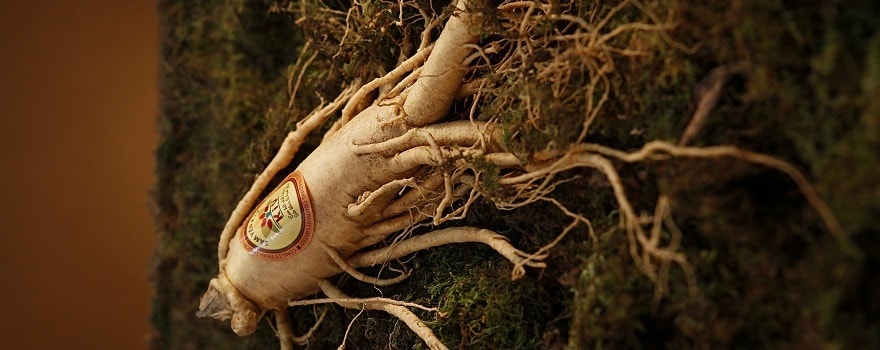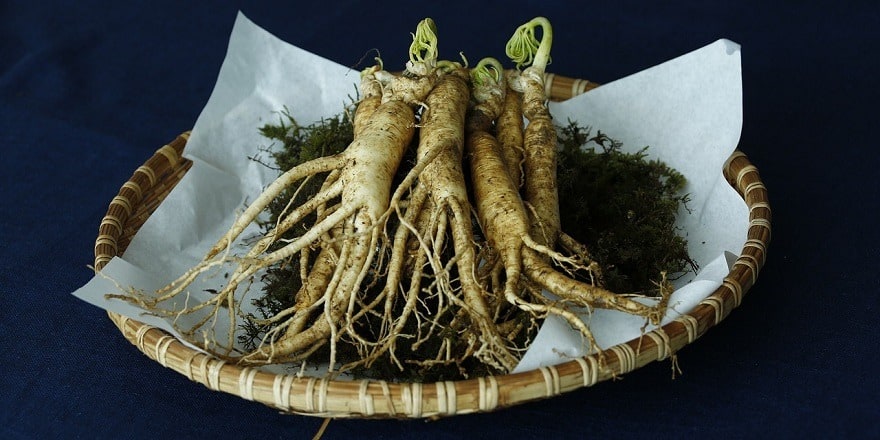American ginseng, Korean ginseng, Siberian ginseng… How to distinguish them?
Asian ginseng, known in Latin as Panax ginseng, is one of the main plants in traditional Chinese medicine. Its name, Panax, means panacea, in other words a universal remedy. The ginseng root has been used for over 2,000 years in Asian medicine as a general tonic, to boost the immune system, and as a sexual stimulant.
Ginseng is an adaptogenic plant, meaning it strengthens the body as a whole and helps it fight off diseases or physical or psychological “stress” that may weaken it.
Ginseng, native to Asia and North America
The ginseng root was so prized in the 17th century that it almost became extinct in the wild. A century later, in the early 1700s, a Jesuit discovered a wild ginseng root on Canadian soil. Already well-known in Asia, its consumption became popularized in America and Europe. Asians subsequently managed to cultivate it, allowing it to be marketed on a larger scale. Today, the Chinese and Koreans are the main producers, followed by the United States and Canada.
American or Asian ginseng?
It is very difficult to distinguish between the two types of ginseng: the Asian ginseng (Panax ginseng) has a peduncle longer than its petiole, which is not the case for American ginseng. The Latin name for American ginseng, Panax quinquefolius, comes from the fact that it has five leaflets, which helps botanists differentiate it from its American cousin.

Ginseng is also distinguished by its color: white ginseng is the root that has simply been cleaned and dried. Red ginseng has been steamed before being packaged, which is often the case with Korean ginseng.
Asian ginseng, like American ginseng, are roots that take quite a long time to grow (on average six years): this explains the often relatively high price of ginseng. Their rarity in the wild means that a wild Asian or American ginseng root can fetch astronomical prices. If you are offered some at a marketplace during a trip to China, be wary!
Other plants bear the name of ginseng, although they are not from the same family: this is the case for Siberian ginseng or Russian ginseng, which is actually another name for eleuthero, and Peruvian ginseng, which is another name for maca, a superfood. Japanese ginseng (ginseng japonicus) is a “true” ginseng, of the Asian ginseng family, although it contains fewer active principles than Korean or Chinese ginseng.
Siberian ginseng or eleuthero
What is called Siberian ginseng or Russian ginseng is therefore not ginseng: it is the nickname for eleuthero, a root from the araliaceae family. It is also used in Chinese medicine for the health of the elderly.
Also read Eleuthero, the Siberian ginseng
Like ginseng, it is a plant called adaptogen, which increases the body’s resistance to stress that may weaken it. It is thus good for stimulating the immune defenses. The World Health Organization recognizes the effectiveness of Siberian ginseng as “a tonic capable of increasing mental and physical capacities during fatigue and during convalescence”. It is also effective in treating osteoarthritis and as a diuretic.
The properties of Asian and American ginseng
The two types of ginseng have relatively similar properties, namely that they help tone the body, act against physical and intellectual fatigue, and make one stronger.
In traditional Chinese medicine, Asian ginseng is rather a “warm” food, meaning it nourishes “Yang” energy, whereas American ginseng is cooler and therefore nourishes more “Yin” energy. In fact, American ginseng is considered more soothing than its Asian cousin.
Both types of ginseng are therefore used in traditional Chinese medicine. American ginseng is especially aimed at calming fever, or soothing the cough associated with some lung diseases. It is also energizing, but has a calming effect on the nervous system.
“True ginseng” or “false ginseng”?
Some pseudo-experts claim that the only “true” ginseng is Asian ginseng or Panax ginseng, the king of remedies. It is said to be more effective and more powerful than its American cousin. However, this isn’t entirely accurate: both American and Asian ginseng are “true” ginsengs, and they simply don’t have quite the same properties for treating the same ailments. That’s why it’s best to consult a specialist who will advise you on which root to choose based on your symptoms.
Choosing the Right Ginseng
Depending on its quality, age, and origin, ginseng root is more or less rich in active ingredients, saponins, and ginsenosides. It’s preferable to choose a ginseng rich in ginsenosides, which will be more effective and more invigorating. A good (and genuine) ginseng has a ginsenoside content between 10 and 15 mg per gram of product (10 to 15% ginsenosides).
Read also | Our tips for choosing the right ginseng
The younger a ginseng is harvested, the less concentrated it will be in active ingredients. It’s preferable to choose a ginseng at least five to six years old, pricier but more concentrated. Generally, if the ginseng is harvested younger, manufacturers don’t indicate its age… So, we watch for this mention, which is a sign of quality.

One can also choose ginseng based on its packaging. The most practical and easiest to dose is ginseng in capsules. It is also available in dry extract form, in powder, but also as fresh root paste to mix with a drink. The fresh root is more rarely found, whole or grated.
Each type of ginseng is suited to your body and its minor ailments. However, if you’re looking for a good general tonic, Korean red ginseng is the most sought-after. It’s best purchased at herbalists or organic stores, or from reliable Internet sites.
We choose organic ginseng to ensure the product doesn’t contain pesticide residues or toxic chemical fertilizers for the body. Indeed, the cultivation of ginseng, which requires a lot of humidity, can sometimes use chemicals even banned in Europe: to ensure its safety for health and the environment, we look for the organic label on products.



